Below is the view up the main street towards the top of the village. You can see The Horse and Groom Public House, known in the village as 'top pub', at the end of the street. This is the street we children would walk down to get to school each morning. Generally calling for each other and walking down in little groups sometimes eager and sometimes not, to get to school.
There were two farms in the village with their farmhouses off this road, the one below is Manor Farm.
Further down the main street, beyond the church, on the way to the school was the village shop and post office. The red brick building to the left of the photo below used to house both the shop and post office, now sadly closed and the house refurbished and called 'The Old Post Office'. The windows on either side of the front door have been cleverly matched so that, other than the name, a visitor would never know that there had ever been a shop there. At the end of the street you can see The Elm Tree Inn, or 'bottom pub' as it was known then. The road to the right of the Elm tree led eventually to the old station, once such a busy bustling place, but closed by the time my mother and I moved into the village.

One of the joys of living in this village was the fact that we lived in such a rural landscape and we could walk out of our back gates and in just a few minutes be in the woods just at the edge of the village.
We had the freedom and security to do that then and we would disappear for hours on end, into the woods by the ruins of the old gamekeeper's cottage,along Vicarage Lane to the sheep dip or up Wood lane to the bridge over the brook. We hadn't a care in the world.
After our quick visit to Scarcliffe we set off to meet up with an old friend from those school days and lots more reminiscing about the old days as well as catching up with more recent news. What a lovely day it was, too.

















































